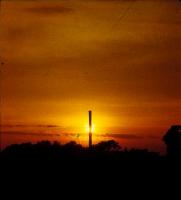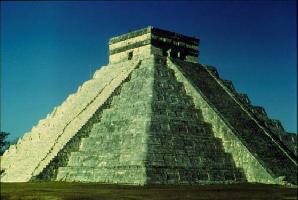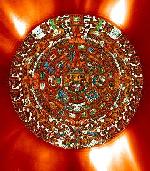
click on image for a larger version
(11 kB jpeg image)
Photo is courtesy of Tom Sever.
|
Woodhenge in Cahokia, Illinois is an example of a relatively simple
observatory. Composed of a circular ring with wooden posts
inserted at specific intervals, one could stand in the center of the circle and sight along a line intersecting the tall post; the posts were used to mark the rising Sun on solstices and equinoxes. These early observatories illustrate the desire of early humans to understand, predict, and perhaps control, the natural world.
|
Between 700 and 1000 C.E., the Toltec/Maya city at Chichén Itzá
flourished. Located on the Yucatán peninsula of Mexico, Chichén Itzá was home to many ceremonial structures.
One very famous structure is today known as el Castillo (or the temple
of Kukulcán). The "castle" which is seventy-five feet high, is composed of nine platforms with a central stairway on
each of the four sides and a top platform. Since each succeeding
platform is narrower than the lower one, the pyramid seems to be much
taller. On the top platform, there is a temple with
a doorway facing each of the stairs, but a main door facing north.
From this doorway, the priests could see the plaza below and they could
observe processions to the Sacred
Cenote (a fresh water sinkhole), which was used for human sacrifice.
Although not an observatory in the sense of the Stone- and Wood- henges,
the architecture of el Castillo commemorates three astronomical events:
the length of the year, the solstices, and the equinoxes.
The length of the year is represented by the number of steps on the
pyramid; there are 91 steps on each of the four sides, totalling 364,
with the top platform counting as 1,
yielding 365. An axis through the northeast and southwest
corners of the pyramid points to the rising sun on the summer solstice
and the setting sun on the winter solstice (this alignment is probable
but not substantiated). Finally, on the day of the equinoxes,
the Sun creates a shadow on the side of the steps resembling an
undulating snake (the snake head is bottom right in the image).
|
 click on image for a larger version
click on image for a larger version
(33 kB jpeg image)
Photo is courtesy of Tom Sever.
|
Press Here for the Next Page
Press Here for the Previous Page
To return to Slide Show Index, click
here.
To return to the Sun in Time home page, click
here.
This work was paid for
by the NASA IDEAS program.
Please direct comments, questions, and suggestions to:
Mitzi Adams
mitzi dot adams @ msfc dot nasa dot gov
(256) 961-7626
Last Updated:
April 23, 2014
|




